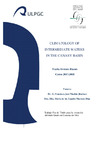Please use this identifier to cite or link to this item:
https://accedacris.ulpgc.es/jspui/handle/10553/75043
| DC Field | Value | Language |
|---|---|---|
| dc.contributor.advisor | Machín Jiménez, Francisco José | - |
| dc.contributor.advisor | Marrero Díaz, María De Los Ángeles | - |
| dc.contributor.author | Brotons Blanes, Marta | - |
| dc.date.accessioned | 2020-10-27T14:10:12Z | - |
| dc.date.available | 2020-10-27T14:10:12Z | - |
| dc.date.issued | 2018 | en_US |
| dc.identifier.uri | https://accedacris.ulpgc.es/handle/10553/75043 | - |
| dc.description.abstract | In the environment of the Canary Basin at intermediate depths, four water masses are observed: North Atlantic Central Water (NACW), modified Antarctic Intermediate Water (mAAIW), Mediterranean Water (MW) and North Atlantic Deep Water (NADW). This region is characterized by a southward-flowing surface current, the Canary Current; and two intermediate currents: a northward associated with mAAIW and a southward with MW. In this research, a Multiparameter Analysis was carried out using a complete database along twenty years supplied by the global project Argo and four oceanographic cruises performed within the framework of the CANIGO project. The main aim of the study was establishing the water masses distribution and their seasonal and inter-annual variability. MW and mAAIW are the predominant water masses at intermediate depths on the north and on the south, respectively, while H and NADW form part of central and deep water, respectively. During summer and fall a northern progression of mAAIW associated to a strong deep poleward undercurrent is followed by southern progression of MW, during winter and spring. In the offshore Canary Basin, the seasonality is not as clear as close to the African continental slope. The discontinuity along the years prevent us to obtain an inter-annual pattern. | en_US |
| dc.language | eng | en_US |
| dc.subject | 251007 Oceanografía física | en_US |
| dc.subject.other | Canary current | en_US |
| dc.subject.other | Argo Project | en_US |
| dc.subject.other | CANIGO project | en_US |
| dc.title | Climatology of intermediate Waters in the Canary Basin | en_US |
| dc.type | info:eu-repo/semantics/bachelorThesis | en_US |
| dc.type | BachelorThesis | en_US |
| dc.contributor.departamento | Departamento de Física | en_US |
| dc.contributor.facultad | Facultad de Ciencias del Mar | en_US |
| dc.investigacion | Ciencias | en_US |
| dc.type2 | Trabajo final de grado | en_US |
| dc.utils.revision | Sí | en_US |
| dc.identifier.matricula | TFT-46509 | es |
| dc.identifier.ulpgc | Sí | en_US |
| dc.contributor.buulpgc | BU-BAS | en_US |
| dc.contributor.titulacion | Grado en Ciencias del Mar | es |
| item.grantfulltext | restricted | - |
| item.fulltext | Con texto completo | - |
| crisitem.advisor.dept | GIR ECOAQUA: Oceanografía Física y Geofísica Aplicada | - |
| crisitem.advisor.dept | IU de Investigación en Acuicultura Sostenible y Ec | - |
| crisitem.advisor.dept | Departamento de Física | - |
| crisitem.advisor.dept | GIR ECOAQUA: Oceanografía Física y Geofísica Aplicada | - |
| crisitem.advisor.dept | IU de Investigación en Acuicultura Sostenible y Ec | - |
| crisitem.advisor.dept | Departamento de Física | - |
| Appears in Collections: | Trabajo final de grado Restringido ULPGC | |
Page view(s)
131
checked on Mar 1, 2025
Download(s)
57
checked on Mar 1, 2025
Google ScholarTM
Check
Share
Export metadata
Items in accedaCRIS are protected by copyright, with all rights reserved, unless otherwise indicated.
